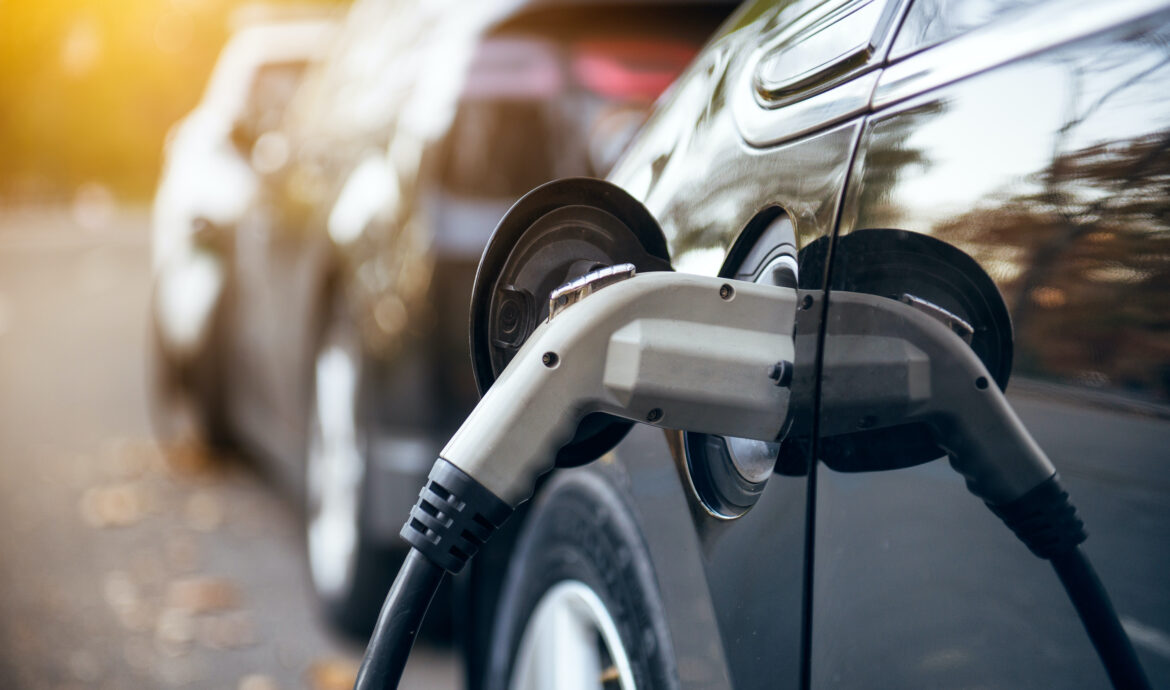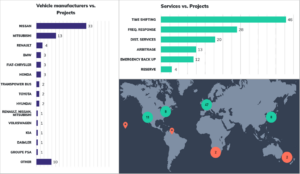
Vehicle-to-Grid (V2G) and car sharing: Joining forces to decarbonize electricity and transport?
On 25.01.2021 by Christine Johanna GschwendtnerChristine Gschwendtner is a doctoral researcher in the Group for Sustainability and Technology at ETH Zurich. With a background in environmental engineering, her research focuses on the interaction between transport and electricity systems. She investigates the integration of low-carbon technologies with particular interest in smart infrastructure, mobility behavior, and demand response.
How can we couple future developments in the electricity and transport systems to support decarbonization? Combining Vehicle-to-Grid and car sharing could foster both innovations and achieve synergies in decarbonizing both sectors.
Increased electricity demand from low-carbon technologies, such as electric vehicles (EVs) and heat pumps, along with increasing shares of renewable electricity generation challenge traditional electricity systems. As renewable electricity supply is intermittent, and EVs and heat pumps increase the total and peak demand of households, matching electricity supply and demand becomes more difficult. To ensure affordable, sustainable, and secure electricity services despite those challenges, we need flexibility services from the demand-side and electricity storage.
How can V2G and car sharing respectively support decarbonization?
Vehicle-to-Grid (V2G) technology enables bidirectional power flows between EVs and the electricity grid. This allows EV batteries to function as low-cost mobile battery storage because they are purchased for their primary use: mobility. While unidirectional controlled EV charging can also offer electricity system services, such as load shifting, V2G can expand these services at both transmission and distribution levels. V2G can therefore not only support the integration of EVs into electricity systems but also the energy transition as a whole, including the integration of renewable energy sources. More than 80 projects worldwide have already implemented different V2G applications, summarized in the database “V2G Hub”.

Figure 1: V2G projects by vehicle manufacturer, electricity system services, and location. Images from the “V2G Hub” database.
Although EVs provide environmental benefits over internal combustion engine (ICE) cars — as discussed in an earlier ETH Energy Blog Post by Martin Beuse — car sharing is another key way to decarbonize individualized road transport. To avoid emissions, car sharing aims to reduce the number of individually-owned cars and trigger a shift towards public transport. There are three main types of car sharing: free-floating (flexible one-way trips), station-based (access and return car at predefined stations), and round-trip (access and return car at the same station). Although the discussion on most effective types of car sharing is still ongoing, studies indicate all three types show a positive effect on the reduction of private car ownership. Round-trip car sharing is most likely to reduce car ownership, can complement public transport and support a modal shift towards it.
Why should we combine V2G and car sharing?
Car sharing could accelerate the uptake of V2G and improve its viability. As a fleet-based service, car sharing is particularly suitable for early V2G uptake because centralized approaches are possible. The concentrated infrastructure serving many cars allows for lower infrastructure installation and maintenance costs. The combination of V2G and car sharing is currently tested in several projects, such as Smart Solar Charging in the Netherlands.
In addition, car sharing can overcome V2G adopters’ concerns about additional battery degradation. While people worry about the impact of increased numbers of (dis)charging cycles on the batteries of their EVs due to V2G, the additional battery degradation could be negligible. In fact, battery life could even be extended if (dis)charging strategies consider which service is provided at what conditions and state of charge. Although more real-life data is required to reduce uncertainty, particularly services based on power availability and low energy usage, such as frequency response, are battery-friendly. To avoid concerns about battery degradation, clear communication and value propositions are required. In contrast to individual people, car sharing operators are likely to have easier access to information and engage more with the technology and (dis)charging strategies – increasing trust in V2G. As car sharing users do not own the cars, and therefore, do not worry about their batteries, car sharing can help to overcome the concerns about battery degradation.
Another benefit is that car sharing operators can gain additional revenue by providing electricity system services with their fleet. Due to high fixed costs and often still low usage rates, car sharing operators face financial difficulties in many cases. V2G can provide revenue when cars are not booked for trips, particularly in regions with a need for local electricity storage and high intermittency of electricity supply. Although both car sharing and V2G aim to increase the asset use of cars — as individually-owned cars are typically not used for mobility during 96% of the time — these innovations are complementary. Electricity system services can be provided during the night or with cars that are less frequently booked, but still required in the fleet.
V2G can also attract more users to car sharing — a vital component! It has already been shown that car sharing is more popular with EVs than with ICE cars because those who like EVs tend to also like car sharing. More and more car sharing operators switch entirely to EVs: just recently, the Swiss car sharing operator Mobility announced their commitment to electrify their fleet. Since V2G-capable cars offer the additional environmental benefit of supporting the energy transition, V2G can make car sharing even more attractive, as investigated in our recent study that compares the attractiveness of V2G-, E-, and conventional car sharing.
What are the challenges?
Despite these benefits, every innovation comes with its challenges. One challenge are infrastructure requirements, which are the biggest obstacle, even for car sharing with unidirectional EV charging. Currently, the most dominant implementation of V2G requires DC chargers, but more AC compatible vehicles (with a converter in the car) are expected in the coming years. Particularly, free-floating car sharing schemes rely on public charging — the use of which might be complicated due to limited availability as well as different ownership and payment structures, as discussed in an earlier ETH Energy Blog Post by Ahmad Al Mugharbil. Some car sharing operators therefore collaborate with retailers, for instance, that install charging stations in their parking lots.

Figure 2: Retailer reserving parking lots with charging stations for car sharing services. Photo: A.v.M.
The behavior of car sharing users is another challenge. As V2G only works when a car is plugged into a charging station, car sharing users need to plug-in the cars after their trips. However, some users might not plug-in their car after use, requiring incentives to steer behavior or staff to plug-in cars — both increasing costs.
The additional costs need to be compared with the additional revenues. The more a car is used for mobility, the fewer electricity system services, and hence revenue, V2G can provide. In addition, the revenue from V2G service provision depends on several local aspects, such as required grid connections and electricity system services in the local operating area.
Most importantly, V2G must not affect the car sharing experience for the user. Mobility needs to remain the primary use of the car. This includes the time a user requires to access and return a car, which are considered very important by car sharing users, but might increase, particularly during the early uptake stages of V2G.
Overall, the electricity and transport systems will converge in the future, which requires further cooperation between the actors in both sectors. Users as central components and the compatibility of future developments in both sectors need particular attention. Car sharing and V2G could improve each other’s business case and scale both innovations, supporting the decarbonization of both the electricity and transport systems.
Cover photo by © [janifest] / Adobe Stock
Keep up with the Energy Blog @ ETH Zurich on Twitter @eth_energy_blog.
Suggested citation: Gschwendtner, Christine. “Vehicle-to-Grid (V2G) and car sharing: Joining forces to decarbonize electricity and transport?”, Energy Blog @ ETH Zurich, ETH Zurich, January 25, 2021, https://blogs.ethz.ch/energy/v2g-and-car-sharing-joining-forces/
If you are part of ETH Zurich, we invite you to contribute with your findings and your opinions to make this space a dynamic and relevant outlet for energy insights and debates. Find out how you can contribute and contact the editorial team here to pitch an article idea!


Mobility without car ownership is predicted by many because it is cheaper, does not require a garage and frees the user from car service duties. Car Sharing is todays option to free one self of a car. In the future robotaxis could be the better and cheaper option. V2G with robo taxis is certainly also possible but perhaps more difficult to realise, because robo taxis woould be always on the street – except when there are no or only few customers – during the night for example.
In any case, Smart Loading – meaning loading in times when there is too much electricity generated – will be easier to implement on a large scale than V2G. I therefore expect smart loading to be often used in the next 10 years. V2G could then follow. Perhaps 20 years from now.
If I were a Grid Operator I prefer more predictable used cars than sharing EV, like company cars, private cars etc. I care for 3 Carsharing EV with often spontaneous reservation
I am a Member of the Standardisation of Charging Emobile, 2009 we created organization rules for V2G, It is the most complex Project in charging Standard. ISO 15118, bidirectional is announced for 2022. OEMs say 2025. Grid operators ?